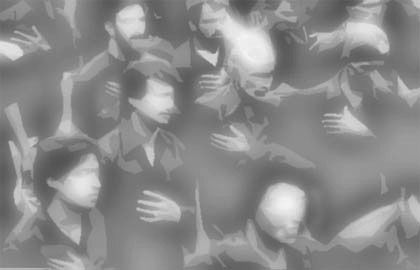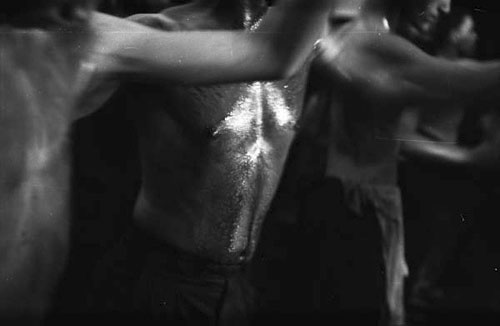Bismillah al-Rahman al-Rahim
Mourning Husayn
On Matam
Updated November 17, 2012 (Written March 2004)

This piece is a brief description of the matam or latum (breast beating) portion of the majlis (gatherings) that are held during the first ten days of Muharram to commemorate the tragedy of Karbala. A majlis typically consists of recitation of marthiya (epic lamentation poetry), followed by a lecture (on some aspect of the Qur'an, islamic philosophy, ethics etc. usually intertwined with a perspective on the history of Karbala - the quality of the content varies greatly depending on the level of knowledge of the speaker). The formal lecture is followed by a brief but intense and emotional description of the martyrdom of one of the companions of Husayn, a different companion each day (Husayn's own martyrdom is related on the tenth of Muharram - Ashura). Then the lecturer (maulana) calls for matam for Husayn and the crowd rises to their feet and begins to beat their breasts - a type of formalized symbolic mourning. The intensity of the matam depends largely on the crowd and on individual proclivities. The majority of people will perform matam lightly, but groups of younger men often engage in a very vigorous, forceful matam - the crowd self-organizes with the more intense matam occuring in the centre of the crowd and the moderate matam towards the outside. This piece is an attempt to capture some trace of the flavor and atmosphere of the matam portion of the majlis of Imam Husayn (a.s.). The scene described is assembled from an amalgam of impressions gathered from attending majlis held by Urdu, Punjabi, Arabic, and Farsi speaking communities in Canada.
Now the maulana's lecture was over, the story of the martyrs was fresh in all minds - tear stains were visible on cheeks and the time to demonstrate the alliance of hearts with the hearts of the martyrs of Karbala had arrived.
The men arranged themselves in long loose lines facing each other - the younger ones (some were attired in baggy jeans and touques or backward facing baseball caps as if they had stopped by at the Islamic centre on their way to a skateboard park), moved to the front lines and faced off against each other. Modern North American youths come to wholeheartedly, unhesitatingly take part in an ancient ritual of mourning. Clusters of young children stood between the two facing lines, the younger ones whispering and giggling as they surveyed the scene around them, too young to be fully in tune with the adult solemnity of the occasion, yet eager to participate as if in a not fully understood game - and pleased to be in a place of attention at the centre of the surrounding adults.
One of the older men, wearing a long black traditional kurta, in a powerful voice began to recite a rhythmical, tuneful chant (a nauha). And as his voice rose and fell, singing out in heart rending verse the story of Husayn's sacrifice at Karbala, the men began to beat their breasts, pounding out a steady rhythmic accompaniment to the verses on their flesh. Their “matam” (breast beating) began slowly, gingerly, then gradually strengthened, settling into a steady metronomic beat. A dramatic, affecting aura settled over the hall, strengthened by the hammering heartbeat like pulse of the matam.
The reciter's voice rose to a peak on the chorus. The others joined their voices to that of the reciter's on the refrain, and a sea of arms flew up and pounded downwards onto waiting chests - repeatedly - with shuddering force. Their entire bodies were involved in the movement - arms swinging in wide sweeping arcs, torsos turning, legs shifting - and the throbbing beat of this unearthly, sorrowful commemoration reverberated heavily through the hall, shaking the light fixtures with it's intensity. Again and again hands descended onto chests, onto hearts that were in this moment united with the heart of Husayn.
The reciter was singing out - his voice breaking as it strained to keep pace with the steady deep thumping of the breast beaters. “Allah Kya jigar tha janabe Husayn ka” - “O God, what a heart this Husayn had!”

The constrained space thrummed with the threnody of united voices echoing the refrain of the reciter. The air was heavy and thick with the heat and humidity generated by the intense activity of so many people in such a tight space. It was a hothouse of physically manifested spirituality - a sacred dance of pouring sweat, of thumping, pounding rhythms spiralling upward to the high peaked ceiling - prayers of the body, not spoken but shouted, rising on the steam released through purified exertions, through matam, lifted on the moisture of expelled breaths, on the cries of “Allah, Allah, Ya Allah”.
Men wept openly - their faces wet with tears - anguished cries rang out and echoed in the hall so that one could almost imagine that the martyrdom of Husayn was unfolding right there, right then, in that hall. Wet eyes gazed into the distance - as if staring out at the scene described in the reciter's verses - their hearts breaking on Husayn's behalf. Such an atmosphere of sorrow filled the hall - an air of heightened spirituality but one laden with heartbreak at the direction Husayn's submission to God was forced to take.
As one reciter ended his nauha, another would step in to take over. The tunes fluctuated in intensity and tempo, and the force of the matam - the breast beating - ebbed and flowed with the changing rhythms. These nauhas pulsed with a magnetic force - their sad melodies, their achingly beautiful words and powerful beat drumming out Husayn's drama of self-sacrifice, absolute commitment, and egoless devotion. Who else was ever mourned this way - who else was ever remembered with such intensity? Here in this hall, another plane of reality arose on the drumbeat of chests and the lamenting cries of Husayn, Husayn. Time was briefly erased as the magnitude of the matam and the absolute concentration of the mourners evoked the memory of the final moments of the martyrs of Karbala - their remembrance hammered into hearts with every beat of hand against chest.
Then a cessation of voices and in the half dark, in the subdued light of that crowded hall there was only the sound of hands speaking to hearts, of palms striking chests, a drumming dirge echoing powerfully - a single mighty heartbeat coalescing from the synchronized rhythm of individual breast beaters - spirits uniting in the remembrance of Husayn, in their dedication to God, awakening to his call - removing, through the enlivening of the hearts, the distance and dross of centuries.
Outside, on the wintery streets, cars ploughed through the snow and slush of Canada's roads. Pedestrians moved through the faded light of the evening, bundled against the chill air while heading past the centre. Perhaps a faint trace of the lilting, wailing cries from within reached them and stoked their curiosity, perhaps the sorrowful nature of the faint, barely discernible remnants of the beat emanating from the centre impinged in some negligible manner upon their consciousness. How curiously incongruous, at this moment, seemed the world outside with the world within. [1] [2] [3]
*
To be notified when new articles are added to this site, please follow @i_from_i (islam from inside). Or, if you prefer, subscribe to the islam from inside RSS feed.
Footnotes
-
1 – Related Articles
-
2 – Matam in the Bible
Mourning and beating of the breast are strongly equated with one another in the Bible. In modern translations, the word rendered as “mourn”, in many instances originally reads as “smiting the chest” or “beating the breast”. As an example, Luke's Gospel describes the gathering of mourners - breast beaters - for Jesus in the following passage:
“When all the people who had gathered to witness this sight saw what took place, they beat their breasts....” (New Testament, Luke 23:48)
So beating of the breast has long been a symbolic method of declaring grief, of mourning. In our times this method of mourning is most conspicuous among the Shi'ites.
Any outsider who attended the Shi'ite commemorative majlis for the martyrs of Karbala would likely be a bit bewildered at the intensity with which these people are remembered and mourned.
This is because the context for the gatherings emerges from a shared culture, history, memory, viewpoint etc. that is gradually acquired as one grows up having prolonged contact with Shi'ite communities and their interpretation of history/religion - one which is integrally connected to love of the Prophet's family as well as to esoteric readings of historical incidences and Qur'anic verses. Mainstream Islamic history is recognized but parallel to it is a history of the corruption of Empire and Husayn's struggle against this corruption.
Without a contextual background the ceremonies of Muharram might be a bit of a head scratcher for outsiders - the intensity of the grieving would likely be bewildering. As an example, often the simple mention of certain names (of the martyred) in the context of Muharram is sufficient to provoke weeping in the audience since the mention of the name in that context evokes a whole world of images in the listeners. And since affection and love binds them to these historical personalities, mentioning their names is sufficient to provoke tears as a sign of that affection.
The most visible symbol of Shi'ite grieving is matam - a formalized beating of the breast that is quite spectacular to behold when carried out by crowds that number in the tens of thousands (in countries with significant Shi'ite populations), but is moving and fascinating to witness even in the relatively small community gatherings in North America.
-
3 – Lamentation Poetry
A heart cleft in two with hurtful sorrow, A ragged wound in my thoughts, these memories painted in blood.
Yet what is this to Zainab’s grief, the bruising pain Which melts her core, the lamenting tears which flood O’er the brim, and veil from her sight the bitter strains And passing shadows of this world.
It holds for her no charm, no desires.
Time’s haze cannot obscure the crimson rain Of innocent blood - sprinkled death at Kerbala.
O’Husayn, when her heart seeks you, where will she find you? The cup of compassion, its tempered metal lies crumpled on the sands And its pure red wine, Streams from its body to be buried in mud.
And Zainab - her soul cries out for what is lost, she laments that the lines Of truth must be written in tears; penned in blood.
- Irshaad Hussain
